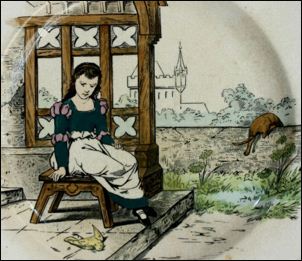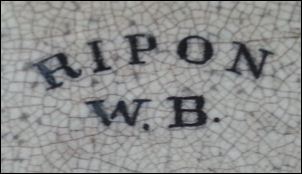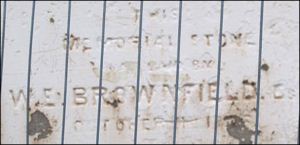![]()
|
W
Brownfield & Son(s) |
Location and period of operation:
|
W Brownfield |
Burslem
|
1850 |
1871 |
|
W
Brownfield & Son |
1871 |
1876 |
|
|
W
Brownfield & Son |
1876 |
1891 |
|
Manufacturers of
earthenware and porcelain
(porcelain introduced in 1871) at Cobridge,
Stoke-on-Trent, England
|
Subsequently: Brownfield Guild Pottery Society
 William
Brownfield Majolica Rustic Ivy Vase modelled as an oak tree with twig handles, covered in climbing ivy and sprigs of acorns. The base rim, sides and interior have a deep turquoise glaze |
|
 hand coloured transferware plate in one of the Mediaeval pattern series
the registration
diamond shows that the pattern was first registered the impressed mark on the left has 4/77
which indicates that |

|




This aesthetic
pattern is attributed to Christopher Dresser who
is known to have produced designs for Brownfield





plates in this style of pattern have various marks
- printed 'No26', hand painted '8755', '8762', '8763', impressed 'BROWNFIELD'
(NOTE: not all plates are marked, some have a couple of the marks, few appear to
have the impressed name mark

Set of Fine China Plates made by Brownfield's China for Tiffany & Co. New York - decorated in Asian style in cobalt and hand-painted gold; each plate individually hand painted in complimentary style to one another. |
 Brownfield's China Tiffany & Co New York the registration number 10361 shows that the design was registered on the 29th July 1884 by W. Brownfield & Sons
|
Initials and marks used on ware for identification:

'RIPON' is the pattern name
WB
W B & S
often including the name of
the pattern.

transferware
pattern
5th January 1864
William Brownfield
sometimes
including an impressed mark of
the Staffordshire knot enclosing the
initials WB

The name BROWNFIELD was also used impressed into the body
from 1871 some marks had "& Son"
from 1876 some marks had "& Sons"
Links for Brownfield:
More connections with William Brownfield:
|
|
|
Biography of William Brownfield:
|
BROWNFlELD, William (1812-73), pottery manufacturer, Hanley. William Brownfield was born in Hanley in 1812. He was the son of Ralph Brownfield who was an earthenware manufacturer and Sarah nee Meigh. After working as a commercial traveller for his father's firm - in 1836 William joined the pottery company of Robinson and Wood, using a works on Waterloo Road, Cobridge [in between Douglas Street and Arthur Street (renamed Crane Street).
He was also a member of Bethesda Methodist New Connexion church. He served as a market trustee and commissioner for Hanley and was chief bailiff in 1844. He favoured Hanley's incorporation as a borough and 1858 became Hanley's mayor in succession to John Ridgway. He was a borough and county magistrate and later a deputy lieutenant. He was a director of the Staffordshire Potteries Waterworks Company and of the North Staffordshire Railway. He gave £500 towards the building of a working men's reading room in the Mechanic Institute in 1859 and in the same year presented the drinking fountain in Fountain Square to the town. William Brown lived in Market (now Huntbach) Street, Hanley, until his marriage to Elle Etches, daughter of a Derby cheese factor, on 14 January 1847. The family lived subsequently at Chatterley House, Old Hall Street, Hanley, where their seven children were born. They moved to Barlaston Hall, Barlaston, about 1869. WB died there on 1 July 1873. A red marble obelisk in Hanley cemetery commemorates him. Courtesy: People of the Potteries. |

Memorial stone laid by W. E.
Brownfield
at the Portland Street Methodist Church
in 1876
Links for Brownfield:
Questions, comments, contributions? email: Steve Birks